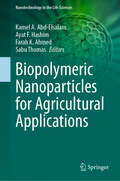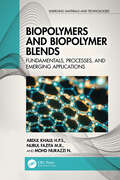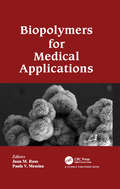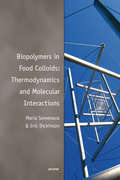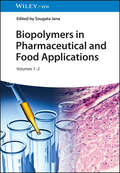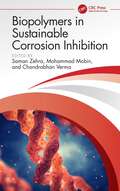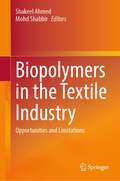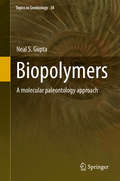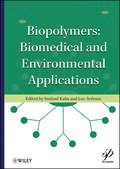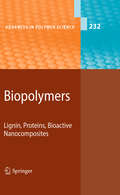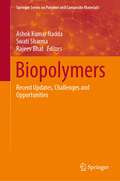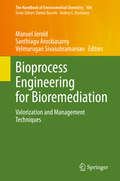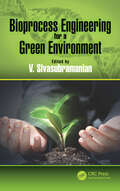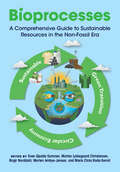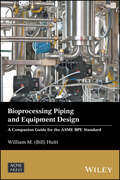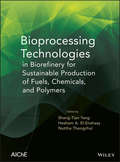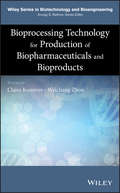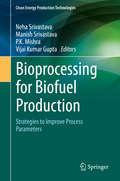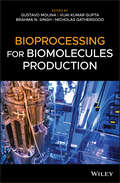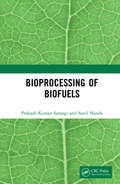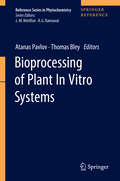- Table View
- List View
Biopolymeric Nanoparticles for Agricultural Applications (Nanotechnology in the Life Sciences)
by Sabu Thomas Kamel A. Abd-Elsalam Ayat F. Hashim Farah K. AhmedBiopolymers are polymers that are naturally sourced from renewable resources such as plants, animals, and microorganisms. These polymers are gaining increasing attention due to their biodegradability, biocompatibility, and non-toxicity, making them an attractive alternative to traditional synthetic polymers. "Biopolymeric Nanoparticles for Agricultural Applications" focuses on the use of biopolymeric nanoparticles for various agricultural purposes. It explores the potential of these nanoparticles in improving crop productivity, enhancing soil quality, and reducing the environmental impact of agricultural practices. Biopolymeric nanoparticles have gained significant attention in recent years as a promising technology for various agricultural applications such as crop protection, nutrient delivery, and soil remediation. These nanoparticles are typically made from biodegradable and biocompatible materials, such as chitosan, alginate, and starch, and offer several advantages over conventional agricultural formulations including improved stability, controlled release, and enhanced efficacy. This book provides a comprehensive overview of recent advances in the design, synthesis, characterization, and application of biopolymeric nanoparticles in agriculture. It discusses the various biopolymeric nanoparticles that can be utilized in agriculture such as chitosan, cellulose, starch, and protein-based nanoparticles. It delves into their properties, synthesis methods, and characterization techniques. The primary purpose of this book is to provide a comprehensive understanding of the applications of biopolymeric nanoparticles in agriculture. It bridges the gap between the fields of nanotechnology and agriculture, offering insights into the potential benefits and challenges associated with their use.
Biopolymers
by David PlackettAs an area of high topical interest, Biopolymers - New materials for Sustainable Films and Coatings covers the development and utilization of polymers derived from bioresources, with a particular focus on film and coating applications.With growing concern for the environment and the rising price of crude oil, there is increasing demand for non-petroleum-based polymers from renewable resources. Leading research groups worldwide in industry and academe are working on such technology with the objective of applying the latest advances in the field.Written by well-respected experts, this text systematically covers the extraction and production of selected biopolymers as well as their properties and application as films or coatings in a variety of uses. The areas addressed include food packaging, edible coatings, paper coatings and agricultural films.Intended for researchers and students, this book will also be of interest to industry, especially in terms of the practical applications.
Biopolymers and Biopolymer Blends: Fundamentals, Processes, and Emerging Applications (Emerging Materials and Technologies)
by Abdul Khalil H.P.S. Nurul Fazita M. R. Mohd Nurazzi N.Biopolymer and Biopolymer Blends: Fundamentals, Processes, and Emerging Applications showcases the potential of biopolymers as alternative sources to conventional nonbiodegradable petroleum-based polymers. It discusses fundamentals of biopolymers and biopolymer blends from natural and synthetic sources, synthesis, and characterization. It also describes development of desired performance for specific applications in 3D printing and other emerging applications in industry, including packaging, pulp and paper, agriculture, biomedical, and marine. Introduces the fundamentals, synthesis, processing, and structural and functional properties of biopolymers and biopolymer blends Explains the fundamental framework of biopolymer blends in 3D printing, featuring current technologies, printing materials, and commercialization of biopolymers in 3D printing Reviews emerging applications, including active food packaging, electronic, antimicrobial, environmental, and more Discusses current challenges and futures prospects. Providing readers with a detailed overview of the latest advances in the field and a wealth of applications, this work will appeal to researchers in materials science and engineering, biotechnology, and related disciplines.
Biopolymers for Medical Applications
by Juan M. Ruso Paula V. MessinaThis book presents an experimental and computational account of the applications of biopolymers in the field of medicine. Biopolymers are macromolecules produced by living systems, such as proteins, polypeptides, nucleic acids, and polysaccharides. Their advantages over polymers produced using synthetic chemistry include: diversity, abundance, relatively low cost, and sustainability. This book explains techniques for the production of different biodevices, such as scaffolds, hydrogels, functional nanoparticles, microcapsules, and nanocapsules. Furthermore, developments in nanodrug delivery, gene therapy, and tissue engineering are described.
Biopolymers in Food Colloids: Thermodynamics and Molecular Interactions
by Maria Germanovna Semenova Eric DickinsonThe theme and contents of this book have assumed a new significance in the light of recent ideas on nanoscience and nanotechnology, which are now beginning to influence developments in food research and food processing. The fabrication of nanoscale structures for food use relies on an in-depth understanding of thermodynamically driven interactions
Biopolymers in Pharmaceutical and Food Applications, 2 Volumes
by Sougata JanaRevolutionize the search for sustainable industry with these biodegradable materials The search for biodegradable materials has become an increasingly essential component of the global response to climate change and the urgent need for more sustainable industrial processes. Biodegradable polymers, either synthetic or natural, have become an explosive research subject as their applications in food, medicinal, and pharmaceutical industries become more and more apparent. There is an urgent need for chemists and other professionals working in these industries to understand the range of available biopolymers and how to use them. Biopolymers in Pharmaceutical and Food Applications presents an overview of all currently-known food-safe polymers and their applications for food and pharmaceutical technology. Its grasp of recent sustainable trends in biopolymer production and distribution make it a one-stop shop for researchers and industry professionals looking to understand the future of sustainable food production, pharmaceutical and cosmetic applications. Comprehensive and accessible, it has never been timelier as a contribution to these key industries. Readers of the two volumes of Biopolymers in Pharmaceutical and Food Applications will also find: Treatment of biopolymers including collagen, chitosan, carrageenan, and more Detailed discussion of drug delivery systems incorporating plant- and animal-based biopolymers An editor with extensive research and teaching experience in biopolymer and pharmaceutical research Biopolymers in Pharmaceutical and Food Applications is ideal for polymer chemists, pharmaceutical chemists, food scientists, and any other researcher looking to work with biodegradable polymers.
Biopolymers in Sustainable Corrosion Inhibition
by Mohammad Mobin Chandrabhan Verma Saman ZehraBiopolymers in Sustainable Corrosion Inhibition covers the fundamentals, properties, and applications of biopolymers and considers their superiorities over traditional alternatives. It explores the synthesis, characterization, inhibition mechanism, and applications of biopolymeric anticorrosive materials.Focusing on environmentally friendly corrosion prevention methods, this book demonstrates how biopolymers slow the corrosion rate and avoid economic losses owing to the metallic corrosion on industrial liners, tools, or surfaces. This book covers the sustainable corrosion inhibition potential of biopolymers and their derivatives, including chitosan, cellulose, chitin, starch, and natural gums.This book will be a valuable reference for undergraduate and graduate students and academic researchers in the fields of biopolymers, corrosion science and engineering, environmental science, chemical engineering, green chemistry, and mechanical/industrial engineering.
Biopolymers in the Textile Industry: Opportunities and Limitations
by Shakeel Ahmed Mohd ShabbirThis book highlights the comprehensive overview of the current status and future potential of biopolymers in the textile industry, including the properties and performance of different types of biopolymers, the applications of biopolymers in various textile products, the challenges and limitations associated with their use, and the environmental impact and economic benefits of biopolymers in the textile industry. The textile industry is one of the largest and most important industries in the world, but it also has a significant environmental impact due to the use of non-renewable and non-biodegradable materials. Biopolymers, which are derived from renewable biological sources such as plants and microorganisms, have the potential to be a sustainable alternative to traditional textile materials. However, the use of biopolymers in the textile industry is still a relatively new and rapidly evolving field, and there is a need for more information and understanding about the opportunitiesand limitations associated with their use.
Biopolymers: A molecular paleontology approach (Topics in Geobiology #38)
by Neal S. GuptaThis book provides an overview, research compendium and an introduction to the science of molecular paleontology, including literature overview for non-geochemists. Analytical methods employed are included as a part of each chapter that underpin this branch of paleontology and indeed geochemistry. The primary usefulness of this volume is for organic geochemists, molecular palaeontologists, and molecular archeologists. Researchers, graduate students and academics interested in astrobiology from a paleontological perspective may also find this to be valuable.
Biopolymers: Biomedical and Environmental Applications (Wiley-Scrivener #77)
by Luc Avérous Susheel KaliaThis handbook focuses on biopolymers for both environmental and biomedical applications. It shows recent advances in technology in all areas from chemical synthesis or biosynthesis to end use applications. These areas have not been covered in a single book before and they include biopolymers for chemical and biotechnological modifications, material structures, characterization, processing, properties, and applications. After the introduction which summarizes the importance of biopolymer in the market, the book covers almost all the topics related to polysaccharides, biofibers, bioplastics, biocomposites, natural rubber, gums, bacterial and blood compatible polymers, and applications of biopolymers in various fields.
Biopolymers: Lignin, Proteins, Bioactive Nanocomposites (Advances in Polymer Science #232)
by Akihiro Abe Shiro Kobayashi Karel Dusˇek-Lignin Structure, Properties, and Applications By H. Hatakeyama, T. Hatakeyama -Tensile Mechanics of α-Helical Coil Springs By A. Ikai -Bioactive Polymer/Hydroxyapatite (Nano)composites for Bone Tissue Regeneration By K. Pielichowska, S. Blazewicz
Biopolymers: Recent Updates, Challenges and Opportunities (Springer Series on Polymer and Composite Materials)
by Rajeev Bhat Swati Sharma Ashok Kumar NaddaThis book emphasizes various challenges and opportunities in biopolymers and identifying their potential applications in various fields including food, pharmaceuticals, cosmetics, and electronics. It offers an overview of the environmental-related issues, regulatory and legislative issues, green extraction technologies, and sustainability challenges. It will be interesting and valuable for researchers working in the related field.
Bioprinting in Regenerative Medicine (Stem Cell Biology and Regenerative Medicine)
by Kursad TurksenThis volume presents the current state of laser-assisted bioprinting, a cutting edge tissue engineering technology. Nineteen chapters discuss the most recent developments in using this technology for engineering different types of tissue. Beginning with an overview, the discussion covers bioprinting in cell viability and pattern viability, tissue microfabrication to study cell proliferation, microenvironment for controlling stem cell fate, cell differentiation, zigzag cellular tubes, cartilage tissue engineering, osteogenesis, vessel substitutes, skin tissue and much more. Because bioprinting is on its way to becoming a dominant technology in tissue-engineering, Bioprinting in Regenerative Medicine is essential reading for those researching or working in regenerative medicine, tissue engineering or translational research. Those studying or working with stem cells who are interested in the development of the field will also find the information invaluable.
Bioprocess Engineering for Bioremediation: Valorization and Management Techniques (The Handbook of Environmental Chemistry #104)
by Manuel Jerold Santhiagu Arockiasamy Velmurugan SivasubramanianThis volume provides an overview of recent trends in bioremediation techniques. Gathering contributions by a multi-disciplinary team of authors, it reviews the available methodologies for the remediation of various types of waste, e.g. e-waste, wastewater, municipal solid waste and algal blooms. Bioprocessing techniques are not only used for environmental cleanup but also for the production of valuable added products from waste biomass. Accordingly, this book provides the reader with an update on current valorization techniques for biofuels, algal biorefineries, and the hydrothermal conversion of biomass. Given its interdisciplinary scope, the book offers a valuable asset for students, researchers and engineers working in biotechnology, environmental engineering, wastewater management, chemical engineering and related areas.
Bioprocess Engineering for a Green Environment
by V. SivasubramanianBioprocess Engineering for a Green Environment examines numerous bioprocesses that are crucial to our day-to-day life, specifically the major issues surrounding the production of energy relating to biofuels and waste management. The nuance of this discussion is reflected by the text’s chapter breakdown, providing the reader with a fulsome investigation of the energy sector; the importance of third-generation fuels; and the application of micro- and macroalgae for the production of biofuels. The book also provides a detailed exploration of biocatalysts and their application to the food industry; bioplastics production; conversion of agrowaste into polysaccharides; as well as the importance of biotechnology in bio-processing. Numerous industries discharge massive amounts of effluents into our rivers, seas, and air systems. As such, two chapters are dedicated to the treatment of various pollutants through biological operation with hopes of achieving a cleaner, greener, environment. This book represents the most comprehensive study of bioprocessing—and its various applications to the environment—available on the market today. It was furthermore written with various researchers in mind, ranging from undergraduate and graduate students looking to enhance their knowledge of the topics presented to scholars and engineers interested in the bioprocessing field, as well as members of industry and policy-makers. Provides a comprehensive overview of bioprocesses that apply to day-to-day living. Is learner-centered, providing detailed diagrams for easy understanding. Explores the importance of biocatalysts and their applications to the food industry, as well as bioplastics production. Examines the unique capabilities of bioprocess engineering and its ability to treat various pollutants. .
Bioprocess Engineering: Downstream Processing
by Pau Loke Show Chien Wei Ooi Tau Chuan LingBioprocess Engineering: Downstream Processing is the first book to present the principles of bioprocess engineering, focusing on downstream bioprocessing. It aims to provide the latest bioprocess technology and explain process analysis from an engineering point of view, using worked examples related to biological systems. This book introduces the commonly used technologies for downstream processing of biobased products. The covered topics include centrifugation, filtration, membrane separation, reverse osmosis, chromatography, biosorption, liquid-liquid separation, and drying. The basic principles and mechanism of separation are covered in each of the topics, wherein the engineering concept and design are emphasized. This book is aimed at bioprocess engineers and professionals who wish to perform downstream processing for their feedstock, as well as students.
Bioprocess and Analytics Development for Virus-based Advanced Therapeutics and Medicinal Products (ATMPs)
by Saurabh Gautam Abhilash I. Chiramel Roland PachThis book reviews the knowledge, methods and available techniques in the rapidly advancing field of virus based vaccines and gene therapeutics. It also highlights new innovative tools and interdisciplinary techniques for bioprocess development and analytics of viruses and viral vectors. As such, it provides a timely and highly relevant resource, since current advances in pharmaceutical research have seen the rise of vaccines and advanced therapeutics and medicinal products (ATMPs), that rely on the power of viruses. However, developing bioprocesses and analytics required to create this often called “magic bullet” (i.e. gene therapy) remains an extremely challenging and costly task. This book offers strategies for overcoming hurdles and difficulties within in all the necessary steps of viral vector development - from scalability to purification methods and quality control. The book is intended for researchers working in academia or industry, as well as graduate students pursuing a career in virology.
Bioprocesses: A Comprehensive Guide to Sustainable Resources in the Non-Fossil Era
by Sven Gjedde Sommer Morten Lykkegaard Christensen Birgir Norddahl Morten Ambye-Jensen Roda-Serrat, Maria CintaIn the rapidly evolving landscape of sustainable energy and resource management, this book is an indispensable resource for students, researchers, and professionals alike. Written by leading experts in the field, it delves into the multifaceted realm of biomass, positioning it as the cornerstone of a non-fossil future. After navigating through the fundamentals, this book discusses the diverse forms of biomass and its use as a renewable and environmentally friendly resource. From the intricacies of biomass production, conversion technologies, and utilization methods, to the economic and ecological implications, each chapter provides a meticulous exploration of key concepts and cutting-edge developments. Questions are posed throughout as well as more than 80 end-of-chapter exercises to gauge reader understanding and translate knowledge to real-world problem solving. Focusing on practicality and real-world applications, this resource not only educates but inspires a shift toward sustainable practices guiding the next generation toward a greener, more sustainable future.
Bioprocessing Piping and Equipment Design: A Companion Guide for the ASME BPE Standard
by William M. HuittThis is a companion guide to the ASME Bioprocessing Piping and Equipment (BPE) Standard and explains what lies behind many of the requirements and recommendations within that industry standard. Following an introductory narrative to the Standard's early history, industry related codes and standards are explained; the design and engineering aspects cover construction materials, both metallic and nonmetallic; then components, fabrication, assembly and installation of piping systems are explored. Examination, Inspection and Testing then precede the ASME BPE certification process, concluding with a discussion on system design. The author draws on many years' experience and insights from first-hand involvement in the field of industrial piping design, engineering, construction, and management, which includes the bioprocessing industry. The reader will learn why dimensions and tolerances, process instrumentation, and material selection play such an integral part in the manufacture of components and instrumentation. This easy to understand and navigate guide will assist engineers (design, piping, chemical, etc.) who need to understand the basis for much of the Standard's content, as do the contractors and inspectors who have to meet and validate compliance with the BPE Standard.
Bioprocessing Technologies in Biorefinery for Sustainable Production of Fuels, Chemicals, and Polymers
by Hesham El-Ensashy Shang-Tian Yang Nuttha ThongchulFor researchers already familiar with biomass conversion technologies and for professionals in other fields, such as agriculture, food, and chemical industries, here is a comprehensive review of the emerging biorefinery industry. The book's content has been conveniently organized according to technologies (biomass feedstock and pretreatment, hydrolytic enzymes in biorefinery, and biofuels), with each chapter highlighting an important biobased industrial product. For undergraduate and graduate students, the book is a thorough introduction to biorefinery technologies.
Bioprocessing Technology for Production of Biopharmaceuticals and Bioproducts (Wiley Series in Biotechnology and Bioengineering)
by Weichang Zhou Claire KomivesWritten for industrial and academic researchers and development scientists in the life sciences industry, Bioprocessing Technology for Production of Biopharmaceuticals and Bioproducts is a guide to the tools, approaches, and useful developments in bioprocessing. This important guide: • Summarizes state-of-the-art bioprocessing methods and reviews applications in life science industries • Includes illustrative case studies that review six milestone bio-products • Discuses a wide selection of host strain types and disruptive bioprocess technologies
Bioprocessing for Biofuel Production: Strategies to Improve Process Parameters (Clean Energy Production Technologies)
by P. K. Mishra Vijai Kumar Gupta Neha Srivastava Manish SrivastavaConverting biomass to biofuels involves hydrolyzing cellulose to sugars using cost-intensive commercial enzymes – an expensive step that makes large-scale production economically non-viable. As such, there is a need for low-cost bioprocessing. This book critically evaluates the available bioprocessing technologies for various biofuels, and presents the latest research in the field. It also highlights the recent developments, current challenges and viable alternative approaches to reduce the overall cost of producing biofuels.
Bioprocessing for Biomolecules Production
by Gustavo MolinaPresents the many recent innovations and advancements in the field of biotechnological processes This book tackles the challenges and potential of biotechnological processes for the production of new industrial ingredients, bioactive compounds, biopolymers, energy sources, and compounds with commercial/industrial and economic interest by performing an interface between the developments achieved in the recent worldwide research and its many challenges to the upscale process until the adoption of commercial as well as industrial scale. Bioprocessing for Biomolecules Production examines the current status of the use and limitation of biotechnology in different industrial sectors, prospects for development combined with advances in technology and investment, and intellectual and technical production around worldwide research. It also covers new regulatory bodies, laws and regulations, and more. Chapters look at biological and biotechnological processes in the food, pharmaceutical, and biofuel industries; research and production of microbial PUFAs; organic acids and their potential for industry; second and third generation biofuels; the fermentative production of beta-glucan; and extremophiles for hydrolytic enzymes productions. The book also looks at bioethanol production from fruit and vegetable wastes; bioprocessing of cassava stem to bioethanol using soaking in aqueous ammonia pretreatment; bioprospecting of microbes for bio-hydrogen production; and more. Provides up to date information about the advancements made on the production of important biotechnological ingredients Complete visualization of the general developments of world research around diverse products and ingredients of technological, economic, commercial and social importance Investigates the use and recovery of agro-industrial wastes in biotechnological processes Includes the latest updates from regulatory bodies for commercialization feasibility Offering new products and techniques for the industrial development and diversification of commercial products, Bioprocessing for Biomolecules Production is an important book for graduate students, professionals, and researchers involved in food technology, biotechnology; microbiology, bioengineering, biochemistry, and enzymology.
Bioprocessing of Biofuels
by Prakash Kumar Sarangi Sonil NandaThe major issues relating to environmental sustainability such as a heavy dependency on fossil fuels, increased greenhouse gas emissions, pollution, global warming and climate change have prompted many efforts around the globe to seek alternative energy sources that have negligible environmental impacts and societal benefits. There is an immense interest in biofuels research throughout the world owing to its massive potential to address environmental concerns. Biofuels have the capacity to supplement current and future energy demands through being blended with fossil fuels or even replacing them completely as drop-in fuels in automobiles as well as for heating and the power industries. Waste biomass, primarily lignocellulosic biomass (e.g. agricultural crop residues, forestry biomass and energy crops) and microalgae can act as some inexpensive renewable bioresources for the production of biofuels and biochemicals. The prime focus of Bioprocessing of Biofuels is to shed light on this significant process, especially through microbial conversion technologies to recover and transform the inedible polysaccharides into hydrocarbon biofuels and bioenergy. The book offers introductory coverage of the most crucial topics as follows: A systematic overview of the state-of-the-art in the production and utilization of biofuels Categorical bioprospecting of bioresources for biofuel production Biomass pretreatment and enzymatic saccharification Bioconversion of waste biomass and algae to liquid and gaseous biofuels New developments in microbial fuel-cell technologies Bioprocessing of Biofuels unites topics related to the cutting-edge applications of bioresources and green technologies to reinvigorate biorefineries, positioning them within a competitive energy market. Written to be instantly applicable, this volume offers a reference book for undergraduate and graduate students, scientific investigators and research scholars around the globe working in the areas relating to energy and fuels.
Bioprocessing of Plant In Vitro Systems (Reference Series In Phytochemistry Ser.)
by Thomas Bley Atanas PavlovThis handbook presents how plant in vitro technologies can overcome current limitations in the production of important plant-derived substances. It explains the advantages of plant in vitro technologies, notably the independence from climatic and soil conditions and the ability to synthesize diverse bioactive substances under controlled conditions. Apart from making diverse metabolites, which can be used e.g. as pharmaceuticals, agrochemicals, flavors, colors, biopesticides or food additives, more easily and more efficiently available, the methods described in this handbook also offer the advantage that rare and threatened plants, which provide access to interesting and desired substances, can be better protected, when the substances are harvested from suitable plant in vitro systems. In times of increasing demand for natural plant-derived products, the described methodologies will be key to ensuring efficient and sustainable access to plant-derived products. They will also help and support in the research and investigation of plant secondary metabolites.Despite these advantages, still only few substances are being produced at industrial scale by in vitro plant cell cultivation systems to date. This handbook therefore advertises the recent achievements and research in the field, focused on solving limitations in yield and bioprocessing conditions. Leading experts summarize the methodology, which can help overcome drawbacks like low yields of target products or problems associated with the cultivation in bioreactors. Readers will find comprehensive information on fundamentals for using different types of plants in vitro as matrix for sustainable production of valuable secondary metabolites. The handbook summarizes the core information on phytochemistry, bioreactor technology and monitoring of plant cells and tissues in bioprocesses. It also discusses selected applications and safety assessment of food and cosmetic ingredients from plant cell and tissue.
